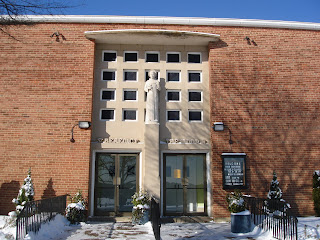Oh, did I mention that D.C. got about three inches of snow yesterday? This is entirely a foreign experience to me, being from Southern California. I marveled at the snowy streets, fields, and parking lots all the way to church while my friend Loreto, from upstate New York, amused himself with my naivety.
St. Benedict the Moor is a small church, built in the mid-twentieth century. It looked a lot like a small version of St. Thomas the Apostle: a square, blunt building. Today was the men’s choir’s turn to perform. The choir consisted of six men, all wearing nearly identical black suits and light blue ties. The boys were a little flat this morning, but they really seemed to be enjoying themselves and it was pleasure to listen to them. I also have to give them credit for singing one of my favorite church songs, “Soon And Very Soon.”
The priest was a young Filipino man, who splits his time between two parishes, St. Benedict the Moor and St. Vincent de Paul. He gives an 8 AM Mass and a 12 PM Mass at St. Vincent de Paul and a 10 AM Mass at St. Benedict the Moor in between. Father Richard’s homily sounded more like a Sunday school lecture than the more abstract reflections on Scripture offered by other priests. I liked his style of preaching, because it was practical. He not only interpreted the readings, but told the congregation how to apply Scripture’s lessons to our everyday lives. He talked about leadership, and the obstacles that stand in the way of becoming a great leader. The first was FEAR. In the first reading, he said, the Lord told Jeremiah not to be afraid to be a prophet, and spread the word of God. The second was FAILURE. While fear prevents us from starting to be a leader, failure keeps us from continuing. Failing to be patient or forgiving, for example, can become an obstacle to success. In today’s Gospel reading, Jesus refuses to perform great miracles for the people of Nazareth after he has performed miracles in Capernaum, and the people run him out of town. This, he said, is an example of another obstacle to leadership, FAVORITISM. When Jesus returns to his hometown of Nazareth, he refuses to grant special favors to the people there, because when you favor one person, you disfavor someone else. We should avoid the temptation to treat people unequally, Father Richard said. The Nazareans said to Jesus, “Hey man, we went to Nazareth Junior High together!” But Jesus’ response was, “Physician, cure yourself.”
I’ve been to two Black Catholic Churches now, and the most remarkable thing about both is the sense of community. There is an incredible connection between the members of the church, whether they are complaining about the snow in the parking lot or smiling and shaking hands after Mass. At the end of the Mass, they asked visitors to stand up and introduce themselves. I stood up, and told them about my project. After Mass, Loreto and I were given a dozen warm welcomes and invitations to return, as well as well-wishings for my project. By the time I left, I felt like I was part of the community too.
St. Benedict the Moor Website (For my Mommy)
Pictures:




 RFK Stadium: This is where UCLA beat Temple in the EagleBank Bowl in December! Also home of D.C. United.
RFK Stadium: This is where UCLA beat Temple in the EagleBank Bowl in December! Also home of D.C. United.
Churches I've Been To So Far:
View Churches I've Been To So Far in a larger map



















